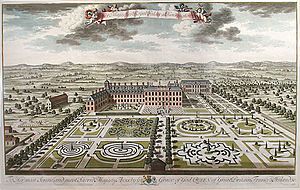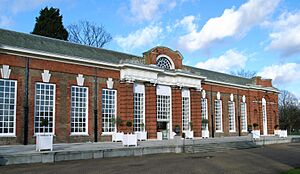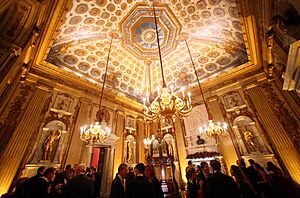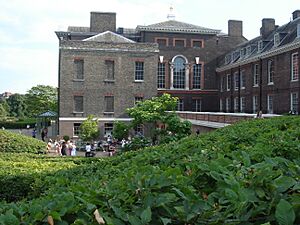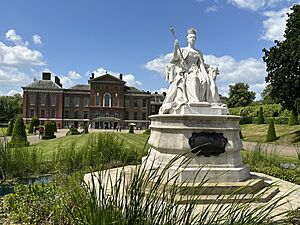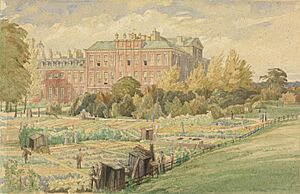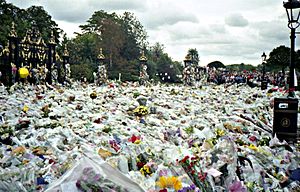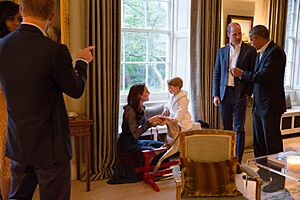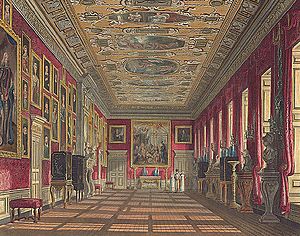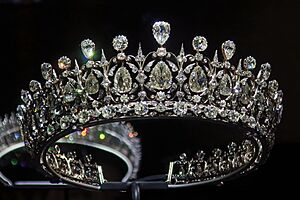Kensington Palace facts for kids
Quick facts for kids Kensington Palace |
|
|---|---|
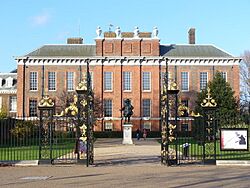
Kensington Palace in November 2006
|
|
| General information | |
| Town or city | Kensington London, W8 |
| Country | United Kingdom |
| Coordinates | 51°30′19″N 0°11′18″W / 51.505278°N 0.188333°W |
| Owner | King Charles III in right of the Crown |
Kensington Palace is a beautiful royal home located in Kensington Gardens in London, England. It has been a home for the British royal family since the 1600s. Today, it is the official London home for several royals. These include the Prince and Princess of Wales, the Duke and Duchess of Gloucester, and the Duke and Duchess of Kent. Also, Prince and Princess Michael of Kent, and Princess Eugenie and her husband, Jack Brooksbank, live there. Sometimes, when people say "Kensington Palace," they are talking about the offices of the royals who live there.
The grand rooms of Kensington Palace are open for everyone to visit. A special charity called Historic Royal Palaces looks after them. This charity does not get money from the government. The palace's offices and private homes are still managed by the Royal Household. You can also see many paintings and other cool items from the Royal Collection at Kensington Palace.
Contents
History of Kensington Palace
King William III and Queen Mary II
Kensington Palace started as a two-story house built in 1605. It was in the village of Kensington.
In 1689, King William and Queen Mary became rulers. King William had asthma, so they looked for a new home. Their old home, Whitehall Palace, was too close to the River Thames. The fog and floods there were bad for his health.
In the summer of 1689, William and Mary bought the house, then called Nottingham House. They paid £20,000 for it. They asked Sir Christopher Wren, a famous architect, to make it bigger right away. To save time and money, Wren kept the main building. He added a three-story section to each of the four corners. This gave more space for the King, Queen, and their helpers.
Wren changed the house to face west. He added wings to the north and south sides. This created a grand entrance area with an archway and a clock tower. The palace was surrounded by neat lawns and formal gardens. These gardens had straight paths and flower beds, like Dutch gardens. The royal court moved into the palace just before Christmas in 1689. For the next 70 years, Kensington Palace was the favorite home for British kings and queens.
Later, Queen Mary made her apartments bigger by adding the Queen's Gallery. After a fire in 1691, the King's Staircase was rebuilt with marble. A Guard Chamber was also built. King William added the South Front, designed by Nicholas Hawksmoor. This included the King's Gallery, where he displayed his art collection. Queen Mary II died of smallpox at the palace in 1694. In 1702, King William fell from a horse and was brought to Kensington Palace. He died there soon after from pneumonia.
Queen Anne's Time
After King William III passed away, Queen Anne lived at the palace. She asked Christopher Wren to finish the parts that William and Mary had started. This became the Queen's Apartments. It included the Queen's Entrance and a simple staircase designed by Wren. The steps were shallow so Anne could walk down easily. These rooms were mainly used by the Queen to go between her private rooms and the gardens.
Queen Anne's biggest addition to the palace was the gardens. She ordered the building of the Orangery, designed by Hawksmoor and changed by John Vanbrugh. It was built in 1704. The inside of the Orangery is very fancy, with carvings by Grinling Gibbons. This shows it was used for parties, not just for growing plants. A huge 12-hectare (30-acre) baroque garden was created by Henry Wise, the royal gardener. It had clipped designs and cone-shaped trees.
Kensington Palace was also where Queen Anne had her final argument with Sarah, Duchess of Marlborough. The Duchess was known for being bossy. She was jealous of the Queen's friendship with Abigail Masham, Baroness Masham. After Anne's husband, Prince George of Denmark, died at Kensington Palace in October 1708, the Duchess acted unkindly. Their friendship ended on April 6, 1710. Queen Anne died at Kensington Palace on August 1, 1714.
King George I and King George II
King George I spent a lot of money on new royal rooms. He created three new state rooms: the Privy Chamber, the Cupola Room, and the Withdrawing Room. In 1722, he hired William Kent to decorate these rooms. Kent painted amazing trompe-l'œil ceilings and walls that looked three-dimensional. The Cupola Room was Kent's first job for the King. Its domed ceiling was painted in gold and blue.
King George I liked Kent's work. From 1722 to 1727, Kent managed all the decorations and art hanging in the royal apartments. Kent's last project was the King's Grand Staircase. He painted 45 interesting people from the Georgian court on it. This included the King's Turkish servants and even himself. King George I also added an apartment on the north-west side for his mistress, Melusine von der Schulenburg, Duchess of Kendal.
The last king to live at Kensington Palace was King George II. He did not make many big changes to the palace. He let his wife, Caroline of Ansbach, manage it. Queen Caroline asked Charles Bridgeman, the royal gardener, to redesign Kensington Gardens. Many of his designs, like the Serpentine lake and the Round Pond, are still there today. After his wife died, King George II did not take good care of many rooms. The palace started to fall apart. King George II died at Kensington Palace on October 25, 1760.
Famous People Who Lived at the Palace
19th Century Residents
After 1760, Kensington Palace was mostly used by less important royals. Prince Augustus Frederick, Duke of Sussex, King George III's sixth son, moved into Apartment 1 in 1805. He loved art and science. He collected a huge library with over 50,000 books. He also had many clocks and singing birds that flew freely in his rooms. He hosted scientists at the palace.
The Duke of Sussex caused a stir because he married twice without the King's approval. His second wife, Cecilia Underwood, Duchess of Inverness, was never officially called Duchess of Sussex. She was made Duchess of Inverness in 1840. The Duke died at Kensington Palace in 1843. Because he had many debts, his belongings, including his library, were sold. The Duchess of Inverness lived at the palace until she died in 1873.
Prince Edward, Duke of Kent and Strathearn, King George III's fourth son, lived in rooms below the State Apartments. He renovated them. His daughter, Alexandrina Victoria, was born there on May 24, 1819. Her christening was held in the Cupola Room. The Duke of Kent died nine months after his daughter was born.
Princess Victoria grew up at the palace. Her childhood was not happy or easy. Her mother, Victoria, Duchess of Kent, and her mother's helper, Sir John Conroy, used a strict system called the Kensington System. Princess Sophia, Victoria's nearly blind aunt, was influenced by Conroy. She spied on the household for him. Conroy wasted most of her money before she died at the palace in 1848.
In 1837, Princess Alexandrina Victoria was told that her uncle, King William IV, had died. She was now queen. She chose the name Victoria and held her first meeting as queen at the palace. Queen Victoria soon moved to Buckingham Palace. She allowed her family and old staff to live in rooms at Kensington Palace. This included the Duke and Duchess of Teck. Their daughter, Queen Mary (King Charles III's great-grandmother), was born at the palace on May 26, 1867. In 1873, Princess Louise lived in an apartment there with her husband.
Princess Louise returned to the palace later. She used her art studio there to design and sculpt the Statue of Queen Victoria, Kensington Palace. This apartment became her main home until she died in 1939. In 1955, the apartment was given to the widowed Princess Marina, Duchess of Kent, and her children. Louise's younger sister, Princess Beatrice, was given the apartments where Queen Victoria and her mother had lived.
20th Century Residents
During World War I, King George V allowed some rooms in the palace to be used for Irish prisoners of war and soldiers. He also made sure the royals living there followed the same food rules as everyone else. The royal residents included Princess Helena, Duchess of Albany, Princess Alice, Countess of Athlone, and Alexander Cambridge, 1st Earl of Athlone. In 1921, Victoria, Marchioness of Milford Haven, moved into an apartment there. Her grandson, Prince Philip, sometimes lived with her. Because so many royal relatives lived there in the 1920s and 1930s, Edward VIII called the palace "the aunt heap."
Kensington Palace was badly damaged during the Blitz in 1940. On October 14, a bomb hit the north side, damaging many buildings. This included the State Apartments and several apartments where royals and staff lived. The garden was filled with anti-aircraft guns and trenches.
Repairs to the palace took several years. After the war, Prince Philip stayed with his grandmother, Victoria, Marchioness of Milford Haven. This was before his 1947 wedding to Princess Elizabeth, who later became Queen Elizabeth II.
With the bomb damage and the deaths of Princess Louise and Princess Beatrice, the palace was neglected. In the 1950s, residents included the Master of the Horse, Henry Somerset, 10th Duke of Beaufort, and Princess Alice, Countess of Athlone. Princess Alice lived there until she died in 1981.
In 1955, the widowed Princess Marina, Duchess of Kent, moved into Apartment 1. This apartment had been empty since 1939. It was divided, and Apartment 1A was created. The stylish Duchess of Kent lived there until she died in 1968.
After their wedding on May 6, 1960, Princess Margaret, Countess of Snowdon, Queen Elizabeth II's sister, and Antony Armstrong-Jones, 1st Earl of Snowdon, moved into Apartment 10. They then began to change the much larger Apartment 1A. The renovation was done on a strict budget. By 1962, the inside was completely redone. All the floors, except the attic, were removed to fix dampness.
The new apartment had main living rooms, three bedrooms, three bathrooms, and rooms for children. It also had nine staff bedrooms and four staff bathrooms. There were many other rooms, including a dark room for Lord Snowdon's photography. The house had a modern look with bold colors like pink and kingfisher blue. The royal couple moved into Apartment 1A on March 4, 1963. Their daughter, Lady Sarah, was born there the next year.
Prince and Princess Richard of Gloucester moved into Apartment 1 after their marriage in 1972. This was the 21-room house where Princess Marina had lived. They raised their three children there. In 1994, the Gloucesters moved the Duke's elderly mother, Princess Alice, Duchess of Gloucester, to Kensington Palace. She died there in 2004 at age 102. She is the oldest person in British royal family history.
The Queen gave the keys to Apartment 10 to Prince and Princess Michael of Kent when they married in 1978. Their children, Lord Frederick Windsor and Lady Gabriella Kingston, grew up there. In 2008, there was some discussion about their rent. However, it was clarified that the Queen paid their rent from her own money. This was because they did royal work and charity work without public funding. From 2010, Prince and Princess Michael started paying the rent themselves. In 1996, Prince Michael's older brother, Prince Edward, Duke of Kent and his wife Katharine moved into Wren House on the palace grounds.
In 1981, Apartments 8 and 9 were combined to create the London home for the newly married Prince of Wales and his wife, Diana, Princess of Wales. It remained Princess Diana's official home after their divorce until her death. Her sons, Princes William and Harry, grew up at Kensington Palace. They went to local schools nearby. According to Andrew Morton, the palace was a "children's paradise." It had long hallways, a helicopter pad, and many gardens.
Several important staff members lived in The Old Barracks building. These included Paul Burrell, Princess Diana's butler, and Lady Jane Fellowes, Diana's sister. Diana's famous TV interview for the BBC's Panorama was recorded in her sitting room at the palace. In February 1987, a thief attacked police guards in the gardens but did not get inside the palace.
When Diana passed away on August 31, 1997, the gates of Kensington Palace became a place of public mourning. Over a million bouquets of flowers were left there. Princess Diana's coffin spent its last night in London at the palace. On September 6, 1997, her funeral procession left the palace for Westminster Abbey. Her home was emptied and remained vacant for 10 years. It was then split back into two apartments. Apartment 8 was used by some of Charles's charities. Apartment 9 became home to the Chief of the Defence Staff.
21st Century Residents
After their wedding in 2011, the then-Duke and Duchess of Cambridge first used Nottingham Cottage as their London home. They then moved into the four-story, 20-room Apartment 1A in 2013. This was Princess Margaret's former home. Renovations took 18 months and cost £4.5 million. This included new heating, electrics, plastering, and removing asbestos. A new roof was also added.
Kensington Palace became the Duke and Duchess's main home in 2017. They moved from their country home, Anmer Hall. The apartment has four stories, with three bedrooms, two nurseries, and five living rooms. In 2016, Diana's former home, Apartment 8, was turned into office space for the couple's staff and charity work. The Duke and Duchess have hosted many events and meetings at the palace.
On March 28, 2012, it was announced that Prince Harry had moved from Clarence House to a one-bedroom apartment at Kensington Palace. From 2013, he lived at Nottingham Cottage. The Duke and Duchess of Sussex continued to live there until their son was born in spring 2019.
In April 2018, Princess Eugenie moved into Ivy Cottage at Kensington Palace. She lived there with her husband Jack Brooksbank until November 2020. In September 2019, the Duke and Duchess of Gloucester moved to the Old Stables, a smaller home on the palace estate. In summer 2022, the Prince and Princess of Wales moved their family home to Adelaide Cottage near Windsor Castle. Kensington Palace remains their official London home and the location of their offices.
Inside the Palace and Its Gardens
Kensington Palace has both public and private areas. It is home to about fifty people. Besides members of the royal family, military members, staff, and other citizens who pay rent also live there.
King and Queen's State Apartments
The King's and Queen's State Apartments are grand rooms. They were historically used by kings and queens for official events and private living. The King's State Apartments were used for meetings with important people. The Queen's State Apartments were more like a private home for queens to live and entertain. These state apartments were first opened to the public in 1899. The museum closed sometimes during World War I and II. It reopened permanently in 1949.
The entrance to the King's State Apartments is the King's Staircase. It has a painting by William Kent showing King George I's royal court. This painting was finished in 1724. The apartment has several reception rooms. The Presence Chamber has a special fireplace where the king would meet ministers. The Privy Chamber was one of Queen Caroline's favorite places for parties. The Cupola Room is described as the "most splendidly decorated room in the palace," also by Kent.
The King's Drawing Room was where courtiers would come to seek power. It has a copy of Venus and Cupid by Giorgio Vasari. The King's Gallery, built for William III, is decorated with red and gold. It was used for exercise and showing off paintings. It has many works by Kent, including Charles I at the Hunt by Anthony van Dyck.
The Queen's State Apartments are the rooms where Mary II and later queens lived. The Queen's Staircase is "deliberately plainer" than the King's. It leads to the gardens. The Queen's Gallery, built in 1693, was once filled with Turkish carpets and items from the East. It was a place for Mary to do "simple pastimes such as walking, reading, and needlework." The Queen's Dining Room is where Mary and William ate meals privately. It has 17th-century wood panels. The Queen's Drawing Room has decorations from China and Japan. Mary's bedroom, where she entertained friends, is also part of these apartments.
Apartments 1 and 1A
Apartment 1 is in the south-west part of Kensington Palace today. It includes much of Sir Christopher Wren's south section. Before the mid-1950s, this apartment was much larger. It included what is now Apartment 1 and Apartment 1A. It had about forty connected rooms over four floors. The main parts of the original apartment faced Kensington Gardens. Even though it's called an "apartment," it's really a very large house.
Prince Augustus Frederick, Duke of Sussex lived in this apartment in the early to mid-1800s. After he died in 1843, his wife Cecilia Underwood, Duchess of Inverness stayed there until she died in 1873. The Duke of Sussex had a huge library that filled many rooms. One wing was completely filled with over 5,000 Bibles. His apartment also had many clocks that chimed every hour.
The next person to live in the apartment was Queen Victoria's daughter, Princess Louise, Duchess of Argyll. She combined smaller rooms to make bigger living areas. She turned one of the Duke's libraries into an art studio. Princess Louise lived in Apartment 1 until she died in 1939. The apartment was empty and neglected for the next 15 years.
Apartment 1: 1954 - Present
In 1954, Princess Marina, Duchess of Kent, who was a widow, was given part of the original Apartment 1. This was her permanent home in London. The original Apartment 1 was too big for Marina. So, its eastern half was divided to create Apartment 1A. The renovation cost a lot of money. Princess Marina and her three children moved in in October 1955. Apartment 1 was Princess Marina's home until she died in 1968.
After Princess Marina's death, it was announced in 1969 that Prince Henry, Duke of Gloucester and his wife Princess Alice, Duchess of Gloucester would move into Apartment 1. They had lived in a larger house before. A palace spokesperson said the apartment at Kensington Palace was "much more compact, modernised and easier to run." Their younger son, Prince Richard of Gloucester, also used the apartment from 1972. After Prince Henry died in 1974, Alice continued to live there until she died in 2004. In 2019, Prince Richard and his family moved to a smaller apartment in the Old Stables Building.
Apartment 1A
Apartment 1A is a royal home with four floors and twenty rooms. It has five living rooms, each with a fireplace. It also has three bedrooms, dressing rooms, and two nurseries. The top floor has nine staff bedrooms. The basement has a luggage room, gym, and laundry rooms. There are three kitchens: one for the family and two for staff. The home overlooks a large, private garden.
The entrance hall has fancy crown moulding and black-and-white tiles. The apartment has art and furniture from the Royal Collection. The Duchess of Cambridge decorated the space with furniture from IKEA. The inside has "warm beiges and floral pillows," gold trim, and detailed carpets.
Other Apartments and Cottages
- Apartment 2: This was the birthplace of Princess Victoria of Kent. Later, Queen Victoria's cousin, Princess Mary Adelaide, Duchess of Teck, lived here. Her daughter, Princess Victoria Mary of Teck (later Queen Mary), was born here. Princess Beatrice of the United Kingdom, Queen Victoria's youngest daughter, also lived here.
- Apartment 4 (The Clock House): Princess Alice, Countess of Athlone lived here from 1923 until she died in 1981. This apartment was badly damaged by fire during the Blitz in 1940.
- Apartment 5: This apartment was occupied by Sir Derek Keppel and his wife, Lady Keppel, during the 1940 Blitz.
- Apartment 6: This was a smaller apartment, home to the Palace Chaplain and later Queen Victoria's Dresser. It was later split into smaller flats.
- Apartment 7: This part of the palace was once a chapel. In 1922, Victoria Mountbatten, Dowager Marchioness of Milford Haven, lived here. She was Prince Philip, Duke of Edinburgh's grandmother. Prince Philip lived with her here before his wedding to Princess Elizabeth in 1947. Later, Mary, Duchess of Beaufort, lived here. After her divorce in 1996, it became the official office of Diana, Princess of Wales.
- Apartment 8: This apartment was granted to Castilia, Dowager Countess Granville, in 1892. Later, Lady Patricia Ramsey lived here. It was damaged by fire during the Blitz.
- Apartment 9: Lady Bertha Dawkins, a Lady-in-Waiting to Queen Mary, lived here. This apartment was hit by a bomb during the Blitz in 1940, causing much damage.
- Apartments 8 & 9: These apartments were combined and renovated between 1975 and 1981 to become the London home of the Prince and Princess of Wales. The nursery covered the entire top floor. It had access to a helicopter pad and several gardens. After Diana's passing in 1997, these apartments were used as office space.
- Apartment 10: This three-story apartment has five bedrooms. Alexander Mountbatten, 1st Marquess of Carisbrooke lived here. It was later home to Princess Margaret and her husband while their larger apartment was being renovated. Princess Margaret called it "the doll's house." Prince and Princess Michael of Kent have lived here since 1978.
- Wren House: Named after architect Christopher Wren, this cottage is near other cottages on the palace grounds. It has five bedrooms and is known for having the "best view" of the palace's walled gardens. Prince Edward, Duke of Kent and his wife Katharine, Duchess of Kent live here.
- Nottingham Cottage: This is a "cosy property" with two bedrooms and a small garden. Prince Harry lived here for a time.
- Ivy Cottage: This cottage has three bedrooms. Princess Eugenie lived here and reportedly decorated it with bright colors and art.
- Old Stables: This residence is also on the palace grounds. It was once described as "lavishly decorated." Prince Richard, Duke of Gloucester and Birgitte, Duchess of Gloucester moved here in 2019.
- King's Kitchen Cottages and the Upper Lodge: These are homes for palace staff.
Chapel
The Kensington Palace Chapel was built in the 1830s. It was used for private family services. It was later changed into living space but was restored as a chapel in 2002. The chapel is about 9 meters long. It has old features and oak wall panels. Renaissance era art from the Royal Collection decorates the room. Family events like weddings and christenings have taken place here.
As a Tourist Attraction
By the late 1800s, the State Rooms were in bad shape. The brickwork was falling apart, and the wood had dry rot. Some people wanted to tear down the palace. But Queen Victoria said that as long as she lived, the palace where she was born would not be destroyed. In 1897, money was approved for its restoration. The work was finished two years later. The State Rooms opened to the public on Queen Victoria's birthday, May 24, 1899. This started the palace's double role: a private home for royals and a public museum.
Queen Mary helped open the State Apartments as a temporary home for the London Museum from 1911 to 1914. The rooms were filled with displays, including 18th-century costumes and dresses worn by queens. The museum returned from 1950 to 1976 before moving to its current location.
In 1989, the care for the Kensington Palace State Rooms was given to the Historic Royal Palaces Agency. This group became an independent charity in 1998. It relies on donations to manage the site. Under this charity, the State Rooms had a two-year, £12 million renovation.
The palace reopened in time for the Diamond Jubilee of Queen Elizabeth II in 2012. Visitors can now choose different routes through the palace. These routes have modern digital displays, interactive experiences, and audio stories. They bring to life the history of the palace and its famous residents. You can learn about William and Mary, George I and II, and Queen Victoria.
Another exhibit shows clothes worn by Queen Elizabeth in the 1950s, Princess Margaret in the 1960s and 70s, and Diana, Princess of Wales, in the 1980s. The palace grounds were also improved. New public gardens were added to connect the palace to Kensington Gardens.
The closest tube stations are Queensway, Bayswater, High Street Kensington, or Gloucester Road.
In October 2011, Disney and Historic Royal Palaces hosted "Rapunzel's Royal Celebration" at Kensington Palace. This special event was when Rapunzel from Tangled became the tenth official Disney Princess. All nine other Princesses attended. They arrived by carriage in a parade through Hyde Park. About 10,000 people watched the parade, and over 100 girls from 25 countries attended the ceremony inside the palace.
See also
 In Spanish: Palacio de Kensington para niños
In Spanish: Palacio de Kensington para niños
- Kensington Gardens
- Kensington Palace Gardens
- List of Baroque residences
- List of British royal residences


